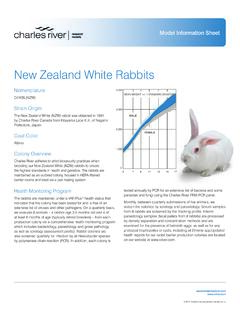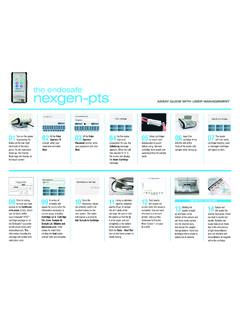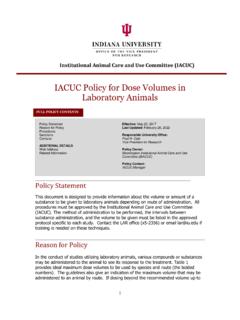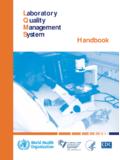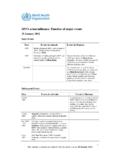Transcription of The Bacterial Reverse Mutation Test
1 CHAPTER 4 The Bacterial Reverse Mutation TestAnnie Hamel1, Marise Roy1and Ray Proudlock21 Department of Genetic Toxicology, Charles River Laboratories, Montreal, ULC, Canada2 Boone, North Carolina, USAC hapter Introduction History Fundamentals Equipment Consumables Reagents and Recipes Ampicillin 2 g/disc Biotin mg/mL Crystal Violet 5 g/disc Glucose g/mL 1M: Glucose-6-Phosphate : 500 M Histidine, 500 M Biotin, 500 M Tryptophan Solution Histidine 5 mg/mL KMg MGA Plates Minimal Glucose Master (MGM, MGMA and MGMAT) Plates NADP M Nutrient Agar Plates Nutrient Broth Phosphate Buffer M pH Positive Control and Diagnostic Mutagen Solutions S9 Fraction S9 Mix Tetracycline 1 g/disc Top Agar Incomplete: TAI Top Agar Complete: TAC Tryptophan 5 mg/mL VB Salts 503: Vogel-Bonner Salts Suggested Phases in Development of the Test The Bacterial Strains Genotypes of Routinely Used Strains Obtaining the Tester Strains 9579 Genetic Toxicology : 2016 Elsevier Inc.
2 All rights Receipt of Bacterial Strains Phenotyping of New Isolates Freezing of Selected Isolates Diagnostic Mutagen Test Routine Testing Designing a Study Metabolic activation system Test Article Considerations Solvent selection Dose volumes Dose levels Positive Controls Standard Test Procedures Plate Incorporation Method Preincubation Method Standard Study Design Examination of the Plates Interpretation of Results Evaluation of toxicity Validity of the study Criteria for negative/positive/equivocal outcome Unexpected and borderline results Presentation of Results Testing of Volatile and Gaseous Compounds Screening tests Simplified Test Systems Screening tests Using Standard Tester Strains Reduced Format tests Using Standard Tester Strains Appendix 1: Growing and Monitoring Suspension Cultures 130 References IntroductionBacterial genetic toxicity tests fall into three main categories: back/ Reverse mutationsingular, forward Mutation , and DNA repair deficiency systems.
3 Those that detect backmutations (reversion of a point Mutation ) are the only ones in widespread use and that aregenerally acceptable for regulatory HistoryOriginally, studies used mutagenic compounds to study the biochemical basis of mutationand to elucidate the structure and organization of the gene. The first demonstration ofchemical induction of Mutation was described by Auerbach and Robson in 1944[1]and80 Chapter 4involved production of mutations and chromosomal aberrations inDrosophilausingmustard gas and related compounds. Demerec[2]showed that various carcinogenicpolyaromatic hydrocarbons also induced mutations inDrosophila. Perhaps realizing thesimplicity, enhanced sensitivity, and rapidity (based on population size and shortergeneration time) of microbial systems, Witkin began work on chemically induced mutationto phage resistance inEscherichia coli[3].
4 Soon afterward, Demerec et al. developed amore practical system quantifying back- Mutation from streptomycin dependence toindependence [4,5]. Dependent cells could divide a few times in the absence ofstreptomycin, allowing a chance for back- Mutation (reversion) to streptomycinindependence, consequently allowing their growth into visible colonies. Szybalski[6]screened more than 400 chemicals using a variation of Demerec s plate-test method inwhich the chemical was applied on a filter-paper disk ( a spot test). Ironically, Szybalskiwas screening for potential antitumor agents as opposed to chemicals that might causecancer; the test was not particularly successful, probably because it relied on a very specificbase-pair reversion at a particular location of the gene, required diffusion of the testsubstance through the agar, and did not allow for mammalian system commonly in use today, requiring an auxotrophic trpAmutation to L-tryptophan independence, was originally conceived by Yanofsky et al.
5 [7],and use of the WP2 strain to quantify mutagenesis was described by Hill[8]. The trpAgene is a part of the trp operon and codes for the tryptophan synthetase chain. The strainsused in routine Mutation tests generally detect base-pair but not frameshift mutations. Thesecan occur at the site of the original Mutation or at a more distant site, which suppresses theoriginal defect. The strains currently used are derived and have anincomplete lipopolysaccharide cell wall making them permeable to larger molecules[9].To some extent, may be considered complementary to theSalmonellatester strains described here and are generally used in conjunction with them[10].The strains constructed by Ames and his colleagues at the University of California inBerkeley were derived fromSalmonella typhimurium(the causative agent in mouse typhoidfever and a variant of the speciesSalmonella enterica) strain LT2 and were originally usedto study genetic aspects of L-histidine synthesis.
6 Mutants were selected based on sensitivityto chemically induced Mutation and their relatively low spontaneous Mutation mutations in the histidine operon are situated at hotspots that are particularly sensitiveto reversion by certain classes of genotoxins, allowing detection of a wide range ofchemically induced base-pair substitution and frameshift mutations. The first use ofSalmonellahistidine requiring mutants to test for mutagenicity involved the carcinogenicmethylating agent, cycasin (methylazoxymethanol glucoside), a carcinogen found in somecycad species[11]. The sensitivity of the strains subsequently selected for routine testingwas enhanced by deletion of the enzyme responsible for the first step in error-free excisionrepair (uvrB) and, in the case of the R-factor (pKM101 plasmid) strains, incorporation ofThe Bacterial Reverse Mutation Test 81the SOS mutagenesis gene umuD (coding for a subunit of DNA polymerase V), whichpromotes error-prone translesion synthesis.
7 The uptake of large and hydrophobic moleculeswas enhanced by selection of strains with a deep rough (rfa) Mutation that leads toincomplete formation of the smooth outer membrane and associated capsule coating thesurface of the bacterium[9]. These strains may be supplemented by a strain with intactexcision repair systems (most commonly TA102) so that cross-linking agents such asmitomycin C (which is lethal to excision repair deficient strains) can be metabolic systems that are present in mammals, but not bacteria, are oftenrequired for conversion of mammalian mutagens to their ultimate active form. These indirectmutagens could be detected in host-mediated assays in which the test organism was injectedinto the animal (often intraperitoneally in mouse), recovered, and plated a few hours aftertreatment of the animal with the chemical[12].
8 However, recovery was variable and thesystem was laborious and not very sensitive. Malling[13]used a mouse liver microsomalfraction to convert dimethylnitrosamine to a Bacterial mutagen. Bruce Ames successfullyadapted Malling s metabolic system using human and phenobarbital or methylcholanthrene-induced rat liver S9 (named after the supernatant postmitochondrial fraction aftercentrifugation at 9000 g) microsomal preparation with cofactors[14]. In this case, thechemical was mixed with the top agar and bacteria prior to plating to establish the standardplate incorporation Bacterial Reverse Mutation test still in general use today. An importantvariation of this system for detection of short-lived reactive metabolites involvespreincubation of the growing test organisms in the liquid phase with the test material and S9while shaking before plating.
9 Bartsch et al.[15]used the preincubation system todemonstrate mutagenicity of the TA1530 was platedin parallel in selective and survival media, so that Mutation frequency could be estimated asin the treat and plate method described later; subsequently, mutagenicity was demonstrated inthe same system with strain TA1535. Yahagi et al.[16]used TA98 and TA100 todemonstrate mutagenicity of a range of N-nitrosamines using a preincubation method;interestingly, DMSO (dimethyl sulfoxide, the most widely used organic solvent inmutagenicity testing) inhibited the activity of dimethylnitrosamine and preincubation method described by Yahagi et al. and the plate incorporation methodversions of the pour plate method are generally the only systems considered acceptable forgeneral regulatory submission. A variation of the preincubation method referred to as treatand plate involves removal of the test agent after the preincubation period, and is usedwhere the test agent shows very strong antibacterial activity in preliminary testing.
10 Mostregulatory bodies require adherence of testing to OECD guideline 471[17], which impliesthat confirmation of negative results ( , apparent absence of mutagenicity of the testmaterial) is expected. Therefore, the plate incorporation and preincubation methods are oftenused in tandem or in sequence to provide a complete study. In contrast, a recent revision ofICH guidance that covers testing of pharmaceuticals in the United States, Europe, Japan, and82 Chapter 4 Canada indicates that a single method and occasion of testing is acceptable when a clearresult is obtained[18]. Other Bacterial Mutation and related methods are available ( , liquidfluctuation, spot and spiral plate, differential killing/repair tests ), but these do not necessarilymeet ICH or OECD criteria and are not recommended for regulatory submission or routineuse except when required by specific FundamentalsThe Bacterial Reverse Mutation test detects point mutations, which are the cause of manyhuman genetic diseases and play an important role in tumor initiation and strains have various mutations that inactivate a gene involved in the synthesis ofan essential amino acid, either histidine (Salmonella) or tryptophan ( ), so they canonly grow in culture medium that is supplemented with that amino acid.







